I know I had posted a cornmeal coo-coo recipe earlier in my blog, but I feel obliged to share this with you again, this time with step by step pictures. I always enjoy coo-coo but sometimes, I forget I am eating a cornmeal dish. It is so smooth and light; I like it with callaloo and stew fish (with just the right amount of pepper in each). They almost seem as if they are made for each other. A romance of foods, I may say.
Cornmeal Coo-Coo Recipe
However, I have been told that this dish is of African origin, just like callaloo. Also, the other Caribbean countries have similar dishes under different names. If anyone out there can verify this I would be thankful.
Anyway, I call this recipe Cornmeal Coo-Coo II.This recipe is a bit simpler and does not require any sautéing. I hope you try it. Enjoy!
CORNMEAL COO-COO II
Ingredients:
1 medium onion, grated
1 tsp. garlic, grated
10 small ochroes, sliced thinly
2 tbsp. powdered seasoning of choice (for taste)
1 tbsp. butter
½ cup water
2 cup coconut milk
1 cup yellow cornmeal
1 tsp. chive
Salt to taste
1 small pepper and pimento pepper, thinly chopped, for taste (optional)
Method:
Heat coconut milk on a low heat.
Cut up the ochroes.
Cook the ochroes in the coconut milk until tender.
Add onion, garlic, chive, salt, pepper, and other seasoning and stir.
Continue to cook on a low heat. Remove from heat and add cornmeal. Return and cook on a low fire.
Mix a little at a time, but stir vigorously until all is added. (Please, ensure that there are no lumps in the mixture). Mix well!
Sometimes a little bit of liquid may have to be added at a time. Add it slowly to avoid the mixture getting too wet. A thick creamy mixture is desirable.
Continually stir the mixture over a low heat and cook for 5 minutes or until most of the liquid is absorbed and a stiff ball is formed.
Remove the coo-coo from the fire when it appears stiff and can hold a peak.
Here, the stiff ball has formed and can hold a peak.
Note, that the mixture does not fall when formed in a ball.
Remove from heat and, at once, pour into a buttered bowl or dish.
Smooth top with the butter using the back of a spoon.
Continue adding a little butter at a time to help smoothen the top.
When done, leave to stand for 15 minutes before serving.
Then turn over onto a serving plate.
This is how the Coo-Coo looks before serving.
Delicious!
Today, I had the coo-coo with fish, in a tomato sauce, fried plantain, and a cucumber and lettuce salad. Did I say this looks delicious?
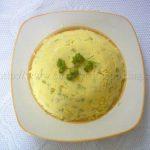
Cornmeal Coo-Coo II
Ingredients
- 1 medium onion grated
- 1 tsp. garlic grated
- 10 small ochroes sliced thinly
- 2 tbsp. powdered seasoning of choice for taste*
- 1 tbsp. butter
- ½ cup water
- 2 cup coconut milk
- 1 cup yellow cornmeal
- 1 tsp. chive
- 1 small pepper and pimento pepper thinly chopp*ed, for taste (optional)
- salt to taste
Instructions
- Heat coconut milk on a low heat. Add ochroes and cook until tender. Add onion, garlic, chive, salt, pepper, and other seasoning continue cooking on a low heat.
- Remove from heat and add cornmeal (mix well). A thick creamy mixture is desirable. Return and cook on a low fire. Continually stir the mixture until most of the liquid is absorbed and a stiff ball is formed.
Don’t forget to leave your comments for this delicious cornmeal coo-coo recipe.

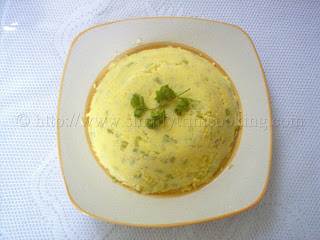
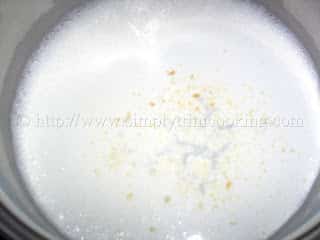
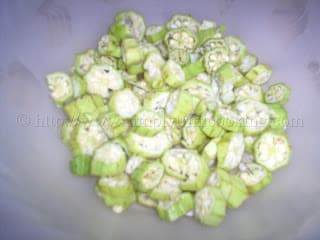
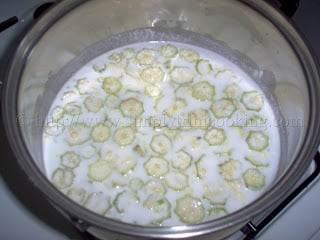
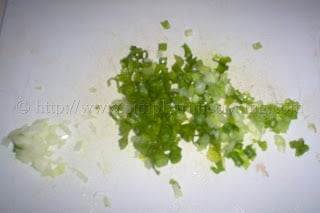
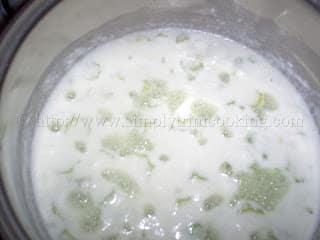
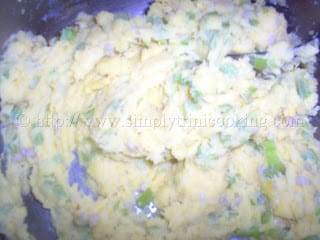

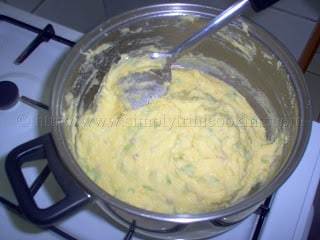
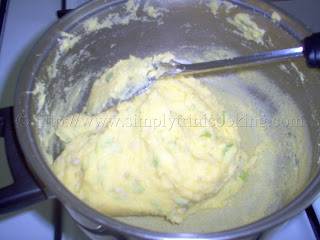
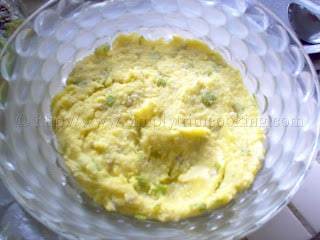
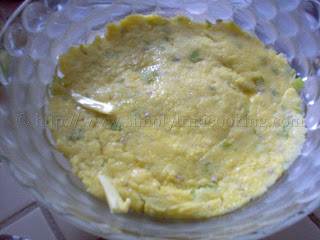
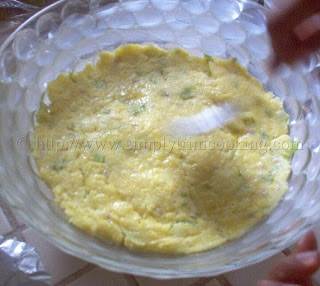
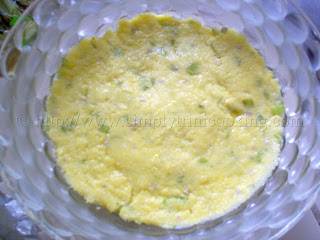

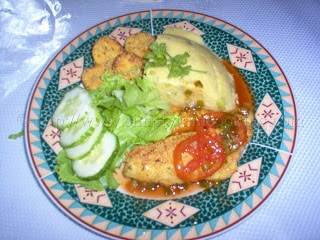
hi, i’ve noticed you’ve said pimento in your recipes and then you’ll say pimento pepper. Is the pimento like a small tiny green caper?
No. Pimento or pimento pepper refers to a type of pepper we use that’s not hot at all. We use it in almost all of our cooking. The second picture in the post below shows how it looks.
http://simplytrinicooking.com/2008/07/pigfoot-souse.html
In Antigua we call this fungee (pronounced foon-gee). We don’t use any green seasonings and we cook the ochroes in just water not coconut milk then add the ochroes and gradually add the liquid to the cornmeal (this is already cooking in another pot with some salted water). Add butter or oil and stir with a pot spoon or a wooden paddle we call a “tun ‘tick” or turn stick (this is also a very effective disciplinary tool I might add-brings back memories) The fungee is ready when it stops sticking to the pot. Take a few spoonfuls and shake around in a small buttered or oiled bowl to form a ball. Serve with stewed saltfish, shad, red herring, mackerel and some steamed mashed spinach, eggplant,and/or pumpkin and green pawpaw.
That fungee sounds delicious especially with the saltfish and mackerel. And that turn stick sure brings back memories on my side as well. Thanks for sharing. 🙂
This is similar to West African fufu. They have something similar done with mashed cassava in West Africa and in much of the Latin Caribbean it is done with green plantains.
This dish is also resembles a dish we have in Jamaica called turn cornmeal, except we may use pumpkin, peas, onion, scallion, thyme or whatever fish or meat you may want to add to turn it into a one pot meal. We also have callaloo here in Jamaica as a lot of dishes from all the different islands are similar but there may be a slight difference in the recipe and name.
No doubt Island Gal there is an underlying commonality in the dishes we prepare from this region. I’m not surprised at this because I had this same discussion with a Puerto Rican and it was the same. The food has different names with just a few variations. Our forefathers have really left us with a rich and diverse cooking culture 🙂
I too make it differently, boiling the ochroes separately and then adding the coconut milk, but in the end the result is the same – delicious. I went to an Italian restaurant and decided to try a dish that was basically steamed sea bass with polenta and vegetables. When the meal arrived and I tasted it, I realized that polenta was actually like coo coo only softer and there was cheese in it. It was delicious though. So this is actually not only a Caribbean or Latin American thing but could this be a variation of a dish from around the world. After all cornmeal is universal.
I agree it could be a variation of a basic polenta.
In east Africa (Kenya and Tanzania) there is a dish called Ugali which tastes exactly like coo coo. They use white cornmeal, but it tastes almost exactly the same and is eaten almost daily!
Since corn/maize is indigenous to the Americas the Ugali dish is most likely derived from another traditional East African dish. Or maybe it’s derived from fungi is a sort of reverse process.
I tried this recipe today and for some reason the cornmeal came out a dark green color in the end result. Do you know what it could have been? It tasted great but the color…
Quite possibly the ochroes could have contributed. That’s the only ingredient I see making the coo coo green. But then, how much small ochroes did you use? The recipe calls for 10 small ochroes because you want them tender. The large ones are rather hard and not suited for this recipe.
Looking to make this recipe tonight with a catfish, salsa and a cucumber salad
thanks for the recipe
I noticed that it mentioned to add liquid to the recipe above if needed. Is this simply referring to water?
Yep
I am using frozen ochroes that are already cut. Can you say how many cups would amount to 10 small ochroes, thily sliced?
About 1 – 1 1/2 cups.
I herd about a Nigerian cassava and plantain dish called fufu. It’s not exactly the same as coo coo because it doesn’t have as much vegetables in it but I’ve been wanting to try it for a while, you should look it up
I know about plantain fufu but would want to do it traditionally using a mortar and pestle.
Love this recipe, my mom made it with diced ham, thyme, garlie, chopped sweet peppers; should I include the ham, when sauteing the veggies??
I’ve never had coo coo with ham in it but yes I would add it to the veggies when sauteing. Would you care to share your version?
Omg it’s my first time making coo coo and I followed this recipe….. it’s looks sooooo good. Can’t wait to try it ! Thank you for this 🙂
When I was a boy living in Bequia, I remember visiting with my grandmother and watching her make coo-coo. My grandmother, like some people in the Windward Islands, customarily made her coo-coo without okra. Coo-coo without okra is called fungie, or fungi which are pronounced “foon-jee”. My grandmother would make a large pot of fungi, store it somewhere cool, and during the week, she would serve rectangles of fried fungi with fried sprat, a type of small herring.